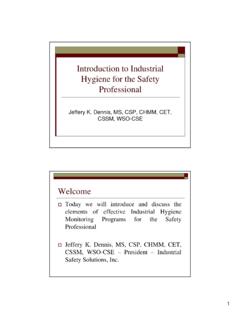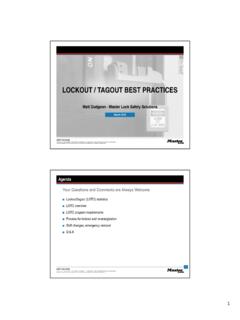Transcription of Root Cause Analysis Tool (RCAT): An Old Tool with a ...
1 3/22/20181 root Cause Analysis Tool (RCAT): An Old Tool with a Critical New Twist for Better Prevention AND Safety CultureCathy A. Hansell, SMS, CSM, CCSR, MS, ; @2010 Breakthrough Results, LLC. All Rights ReservedRCAT: Old Tool with a New TwistAgenda: Assumptions root Cause Analysis Tool (RCAT) Definitions Process Considering the Influencers : What People Know, See and Feel root Cause Chart Tips and Traps Practical Application3/22/20182 Assumptions An underlying root Cause and other contributory causes People react to their current work design, people and systems First seek the underlying work, safety management system and cultural defects, not placing blame. A tool easy to use and effective for future preventionRCAT: Old Tool with a New TwistIncident Investigation Process MapRoot Cause Incident Investigation and Corrective Action ProcessKey Process InputKey Process OutputAmerican Standard Incident Investigation ProcedureLocal Incident investigation procedureLocal Regulatory requirementsSite employee listinglisting with incident investigation team membersManagement decisionIncident investigation proceduremembers trained, ready to deploy procedureIdentified team membersBroken ProcessUnsafe ActsFatality, Injury, First aid, Near missUnsafe ConditionsEnvironmental SpillQuestions : Who ?
2 What? When? Where?Problem Statement (concise event description)Incident investigation procedureIncident investigation startProblem Statement6 hoursInterviewsObservation- Documented direct evidence (scene, witnesses)Photo's- Indirect evidence (written sources)Direct/Indirect evidence5 WhyFishbone with 6 M'sExcell tab Immediate Cause listing24 hours Answer on "How the accident happened"Fishbone with immediate causes 5 WhyRoot Cause and contributory Cause listingExcell tab Potential system Cause listing48 hoursRoot Cause and contributory Cause listing 72 hours Corrective action plan with responsible person and target datePreventive action plan with responsible person and target dateRoot Cause listingReport and actions approved by managementAction planAction plan - action stepsCorrected work environmentSafety AlertContinuous improvement Corrected work environmentIncident investigation reportDevelop Local Incident investigation ProcedureIncident notificationINCIDENTP repare team members through training and exerciseSelect possible incident investigation Team membersIdentify System root Cause for each immediate
3 CauseAppoint team leader and activate teamCollect evidenceOrganize evidence for immediate Cause identificationDevelop proposal for corrective action that eliminate identified root causesShare key learningsPrepare report for management approval Implement corrective actions and check effectivenessRCATRCAT: Old Tool with a New Twist3/22/20183 Problem Obstacle to safety. The effect of an incident root Cause Basic, underlying reason for an undesirable condition or problem which, if eliminated or corrected, would have prevented the problem from existing or occurring. Systemic, process, long term causes : Immediate seen ; short term Contributory worsens effect, severity and frequency of problem; short term Solution Permanent elimination of the problem and root Cause . Implementation Action plan: documentation; introduction; training, tracking and : Old Tool with a New TwistFishbone (Ishikawa) Diagram (six M s: Man, Materials, Method, Machine, Measurement/Metrics, MotherNature\Environment)Five WHY technique or Fault Tree.
4 Add other influencersUtilize the root Cause chart to identify personal andjob factors and specific underlyingroot causeLink causes to the Maturity Path/Management SystemUNDERSTAND THE WORK PROCESS AND INFLUENCERSCORRECTIONS Implement, track and monitorQuick ReviewRCAT: Old Tool with a New TwistProcess 3/22/201841. Work process steps, equipment, support processes2. Working environment3. Influencers People Know People See People Feel4. Personal Factors Work history, physical condition Process and InfluencersRCAT: Old Tool with a New TwistMetrics/MeasurementMaterialsMethods Mother Nature/EnvironmentMachinesManpowerEffect The Fishbone Diagram:Suggested format (Injury/Illness) from (Event or Task)RCAT: Old Tool with a New Twist3/22/201851. Why did the shipment arrive late? The driver did not get to work on time blame the driver2. Why did the driver not get to work on time?
5 He over slept blame the driver3. Why did he oversleep? He was working too much overtime blame the driver 4. Why was he working too much overtime? There weren t enough drivers available System problem5. Why weren t there enough drivers available? Because three drivers quit last week System problem5 Why ExampleRCAT: Old Tool with a New Twist 5 Why s TIPS AND STEPS1. Use a fishbone chart to identify immediate causes . Consider these the 1stwhy of 5 whys 2. Brainstorm possible causes from these first immediate causes . These will be the 2ndwhy of the 5 whys .3. Select a target for deeper root Cause evaluation: Look for reoccurring pattern of causes ; or an issue, which if solved, would remove all others causes . 4. Brainstorm possible deeper ,4thand 5thwhys5. Selecting the root Cause by definition: Basic reason for an undesirable condition or problem which, if eliminated or corrected, would have prevented the problem from existing or good root Cause is one where we can change or influence a process or system to remove the reason or influence for an unsafe act or : Old Tool with a New Twist3/22/20186 Look at the: work process work systems the people know, see and feel as possible root Cause , and contributing causes RCAT: Personal or Job factor Check Chart for specific : Old Tool with a New Twist 5thRCAT SELECTION TIPS AND STEPSRoot Cause Analysis Tool - ChartRCAT: Old Tool with a New TwistCopyright @2010 Breakthrough Results, LLC.
6 All Rights Reserved3/22/20187 root Cause Analysis Tool Chart (partial detail view)Leadership and Management Commitment (A)Associate Involvement (B)S&H Business Integration (C)S&H Risk Identification and Exposure Assessment (D)S&H Risk Reduction and Management (E) S&H Procedures (F)S&H Training (G)S&H Resources (H)S&H Metrics and Data Analysis (I)KEY: American Standard Maturity (A)Conflicting roles/responsibilities (C)Lack of contractor (C)Inadequate technical (C)Inadequate work (A)Inadequate (C)Inadequate contractor (C)Inadequate technical design: design input (E)Inadequate Preventive (E)Inadequate correction of worksite/job (C)Inadequate contractor selection (C) Inadequate technical design: design input not (D)Inadequate Preventive maintenance: assessment of (D)Inadequate identification of worksite/job (A)Use of non-approved contractor (C)Inadequate technical design: design input not (E)Inadequate Preventive maintenance: (C)Inadequate management of change (D)Lack of job (C)Inadequate technical design: design input (E)Inadequate Preventive maintenance: (E)Inadequate incident reporting/investigation (D)Inadequate (C)Inadequate technical design: design output (E)Inadequate Preventive maintenance: (A)Inadequate or lack of safety (C)Inadequate technical design: design output (E)Inadequate repair (C)Inadequate performance measurement and (C)Inadequate technical design: design output not (E)Inadequate repair maintenance: communication of needed repair8.
7 Management / Employee Leadership9. Contractor Selection and Oversight10. Engineering Design11. Work PlanningRCAT: Old Tool with a New TwistCopyright @2010 Breakthrough Results, LLC. All Rights ReservedTarget Areas1 BEGINNING 2 MEETING MINIMUM STANDARD4 SUCCEEDING5 LEADINGESSH Integration into all ISC Processes (ops, engineering, maintenance, procurement, )oSafety impacts are considered in the management of change process, but not on a routine basis and not always early enough in the process. oSafety issues are not incorporated at all or timely enough into other ISC operational, planning, or decision work practices and procedures are documented for all significant work done on the process, including noting and addressing safety impacts, is understood and documented in all regulated change management eventsoOther ISC processes and Commercial decisions incorporate ESSH issues timely in the processoMost operational work practices and procedures include a description of the safety hazards, and precautions of doing the prescribed MOC process, including noting and addressing safety impacts, is common at all sites with identical safety review is documented for all projects & major maintenance events (overhauls, turnarounds)oCommercial planning (new product development, ) includes a documented safety review early in the decision making process.
8 OAll ISC and Commercial processes facilitate safety risk reduction strategies in all decisions work practices and procedures are periodically reviewed for changes from actual practice, procedures are updated as needed, and gap training is completed to ensure all employees know the best, current procedures, safety risks and safeguards..oMOC process best practices are shared across all ensures that safety considerations are properly integrated into all business processes, tools and ensures that environmental, security and health (ESH) considerations are also properly integrated into all business processes, tools and decisions. oSafety and ESH are considered a strategic component of business and workforce processes effectively work together to reduce risks and exposure to hazards and make sound safety and ESH decisions, as early as process is in place to benchmark operational work practices and procedures with all five plants and with best in class companies from safety and ESH Portion of a Maturity Path RCAT: Old Tool with a New TwistCopyright @2010 Breakthrough Results, LLC.
9 All Rights Reserved3/22/20188 Corrective action refer to maturity path or management system Short term corrections for immediate causes Long term preventative corrections for root causeGood corrective actions will change a process or accepted way of working or behaving. Track, monitor, audit Continue the improvement process Select immediate causes and contributing factors to solve other immediate problems: short term solutions. : Old Tool with a New Twist Corrective Action TIPS AND STEPSNow what?.. Think pro actively Uses of RCAT Accident Incidents Risk Analysis hazards and exposures Current Safety ProgramsRCAT is a structured way to why did this happen ? or why do we do things this way now ? Can it be changed to be safer?RCAT: Old Tool with a New Twist3/22/20189 TipsPreparation :1. Maturity path or management system2. old myths 3. it easy4. Review and monitor the process5.
10 Track closure of corrective actions6. Track effectiveness of corrective actionsRCAT: Old Tool with a New TwistTipsUsually a Culture Business integration root Cause ..1. Unplanned events or tasks2. Not do a pre job or pre task review3. Insufficient manning, equipment, time, 4. Job design with inherent hazards or risks not removed or not mitigated 5. Routine job turns non routine and no MOC done6. Unit or plant does not see the risk work is routine, usual leads to no procedures, no training, no enforced pre job reviews, undefined ppe, different ways to do the jobCultural Leadership1. Unsafe acts condoned2. Unsafe tools, equipment and processes condonedRCAT: Old Tool with a New Twist3/22 influences, as contributing factors, but are usually not root causes :1. Not ask for help2. Rushed3. New reluctant to ask for help4. Seasoned vet complacent with long standing work tasks and inherent risks; established work arounds5.



